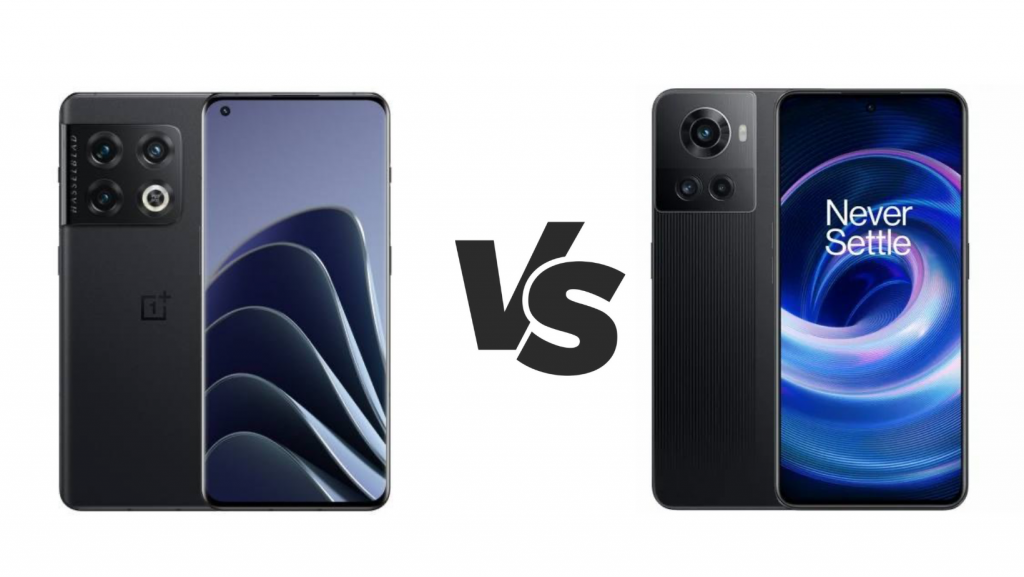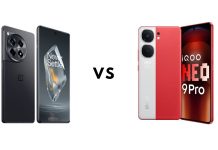OnePlus has finally released its flagship for the second half of the year, and it’s none other than the OnePlus 10T. The phone comes with better performance and faster charging than the OnePlus 10 Pro, but an inferior set of cameras, without the Hasselblad branding.
However, today, we’ll compare this newly announced smartphone with another device in the OnePlus lineup, the OnePlus 10R. This upper mid-range device is placed below the OnePlus 10T but shares a number of features with the new model. So, let’s take a closer look at how the 10R compares in front of the OnePlus 10T.
OnePlus 10T vs OnePlus 10R
| OnePlus 10T | OnePlus 10R | |
|---|---|---|
| DIMENSIONS AND WEIGHT | 163 x 75.4 x 8.8mm, 204 g |
163.3 x 75.5 x 8.2 mm, 186 g |
| DISPLAY | 6.7 inches, 1080 x 2412 pixels (Full HD+), AMOLED | 6.7 inches, 1080 x 2412 pixels (Full HD+), AMOLED |
| PROCESSOR | Qualcomm Snapdragon 8+ Gen1, octa-core 3.19 GHz | Dimensity 8100-Max AI boost, octa-core 2.85 GHz |
| MEMORY | 8 GB RAM, 128 GB – 12 GB RAM, 256 GB – 16 GB RAM, 256 GB | 8 GB RAM, 128 GB – 8 GB RAM, 256 GB – 12 GB RAM, 256 GB |
| SOFTWARE | Android 12, OxygenOS 12.1 | Android 12, OxygenOS 12.1 |
| CONNECTIVITY | Wi-Fi 802.11 a/b/g/n/ac/6, Bluetooth 5.2, GPS | Wi-Fi 802.11 a/b/g/n/ac/6, Bluetooth 5.2, GPS |
| CAMERA | Triple 50 (Main) + 8(UW) + 2 MP (Macro), f/1.8 + f/2.2 + f/2.4 16 MP f/2.4 front camera |
Triple 50 (Main) + 8(UW) + 2 MP (Macro), f/1.8 + f/2.2 + f/2.4 16 MP f/2.4 front camera |
| BATTERY | 4800mAh 150W | 4500mAh 150W |
| ADDITIONAL FEATURES | 5G, dual SIM | 5G, dual SIM |
Design
The OnePlus 10T adopts the same design philosophy as its more expensive sibling, the OnePlus 10 Pro. The phone features a slab design with rounded corners and a camera housing that curves into the left side. In fact, you would have had a hard time distinguishing the two models if not for the placement of the LED flash in the camera housing. The OnePlus Pro features the LED ring flash near the bottom right corner of the housing while the OnePlus 10T shifts it to the top right corner.
As for the OnePlus 10R, the phone features a different design philosophy than its more expensive siblings, coming with a flatter and half-textured back. The design is different from what you see on OnePlus devices, so it stands out. The 10R is also slimmer and lighter than the 10T at 8.2mm (vs 8.8mm) and 182 grams (206g).
Notably, both the OnePlus 10T and the 10R skip the iconic alert slider usually found on OnePlus smartphones. They also do not feature any IP certification.
In the design department, it all boils down to individual preferences. The 10T’s design feels more premium with its curvier profile, but some people may prefer the 10R’s flatter and unique design.
Display
Surprisingly, both the phones have the exact same displays.
The 10T and 10R models come with a 6.7-inch FHD+ Fluid AMOLED display with HDR10+ certification. The displays are protected by Corning’s Gorilla Glass 5 and have a 120Hz refresh rate.
Since the two phones have the same displays, there’s no point in picking a winner in this department. Your buying decision will be influenced by the other departments in the comparison, especially the next one – performance.
Specs & Software
While smartphone processors, especially in the mid-range segment have evolved significantly over the past few years, smartphones with the fastest performance are still valued in the market. And that’s why the OnePlus 10T has a significant edge in this comparison. It’s one of the fastest smartphones in the market today, all thanks to the Snapdragon 8+ Gen1 processor inside with up to 16GB of RAM. Notably, even the OnePlus 10 Pro, which is costlier than the 10T comes with an older processor.
On the other hand, the OnePlus 10R features the MediaTek Dimensity 8100-Max. The processor is pretty good in the mid-range segment, but will definitely lag behind the 10T in terms of performance and speed.
For gaming and resource-intensive tasks, there is no doubt that the OnePlus 10T would outperform the 10R.
Being two phones from the OnePlus stable, both the models run on Android 12-based OxygenOS 12.1 and will have a similar software experience.
Camera
Like the display department, the camera setup is also exactly the same in both models.
The two phones feature a 50MP primary camera with OIS, an 8MP ultra-wide shooter, and finally, a 2MP macro camera. Even the selfie cameras are exactly the same – a 16MP punch hole shooter.
Despite having the exact same camera setups, the OnePlus 10T is likely to have an advantage. With the fastest and the latest Qualcomm processor inside, the image processing is also expected to get an upgrade, meaning the 10T could output slightly better images than the 10R.
However, we’ll have to wait and see a real-life camera comparison between the two models to make the final call.
Battery
Both have similar battery capacities. The OnePlus 10T comes with a slightly larger 4800mAh battery on board with an ultra-fast 150W charging support. On the other hand, the OnePlus 10R (top-end model) features a 4500mAh battery with the same ultra-fast 150W charging technology.
These are the two of the fastest charging smartphones in the world right now, and you won’t go wrong getting either of them.
Price
The OnePlus 10T starts at ₹44,999/$649/£629/€699. On the other hand, the OnePlus 10R is available for a slightly cheaper price tag in India at ₹39,999.
The final purchase decision will boil down to two main areas – performance and budget. If you want a smartphone with the best performance on the market, the OnePlus 10T, even at its slightly higher price tag, will be a no-brainer for you. On the other hand, if you are looking for a phone that’s cheaper, performs like a mid-ranger, and charges extremely fast, it makes sense to get the 150W version of the OnePlus 10R.
OnePlus 10T vs OnePlus 10R: PROs and CONS
OnePlus 10T
PRO
- The latest and greatest processor of 2022
- Good Cameras
- Super fast 150W charging
- Premium design
CONS
- No IP Rating
- No Wireless Charging
- Average Cameras
OnePlus 10R
PRO
- Superfast 80W / 150W charging
- Slimmer and lighter form factor
- Cheaper price tag
CONS
- Average Cameras
- No Wireless Charging
- No IP rating
RELATED
- Best Smartphones Under Rs 50,000 In India
- Xiaomi Mi 11 Ultra vs Samsung Galaxy S21 Ultra vs OPPO Find X3 Pro: Specs Comparison
- The Best OnePlus 10T Alternatives in India
- Best Wireless Earbuds For 2022: Here Are Our Top Picks








